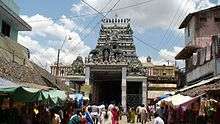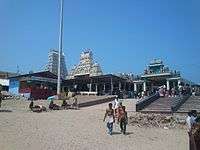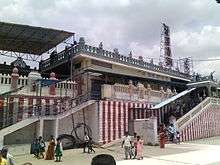Six Abodes of Murugan
| Six Abodes of Murugan | |
|---|---|
| Name | |
| Other names | Aarupadai Veedu |
| Proper name | Six Holy abodes of Lord Muruga |
| Tamil | அறுபடை வீடு |
| Geography | |
| Country | India |
| State | Tamil Nadu |
| Location | Thiruthani, Swamimalai, Pazhani, Pazhamudircholai, Thiruparankundram, Thiruchendur |
| Culture | |
| Primary deity | Kartikeya |
| Important festivals | Kaumaram, Thaipusam |
| Architecture | |
| Architectural styles | Dravidian Architecture |
| Number of temples | 6 |
The Six Abodes of Murugan (Tamil: Āṟupaṭai vīṭu) are six temples situated in the state of Tamil Nadu in South India. The god is known by different names such as Karthikeya, Skanda, Vadivela and Muruga at various temples. The six most sacred abodes of Murugan was mentioned in Tamil sangam literature, "Thirumurugatrupadai", written by Nakkeerar and in "Thiruppugazh", written by Arunagirinathar. The six abodes are Thiruthani, Swamimalai, Palani, Pazhamudircholai, Thirupparankunram and Thiruchendur.
Murugan
The story of Lord Murugan is described in Skanda Purana. According to the legend, in the olden days the demon Soorapadman tortured the Devas, who went to complain to Lord Vishnu and Brahma. They assigned Kamadeva to awake Lord Shiva from his penance, who later gave birth to Kartikeya. Karthikeya killed Soorapadman and saved the devas. Muruga is depicted as the god of love and war. Kartikeya married Valli by love and married Deivayanai by winning the war held at Tiruchendur.[1]
In Tamil literature five types of lands are explained. They are Kurinji (mountainous region), Mullai (forest region), Marutham (agricultural region), Neithal (coastal region) and Palai (desert region). Separate gods for these land types are clearly told in Sangam literature. According to the literature Lord Muruga is the god of mountainous region,.[2]
Religious importance
Arunagirinathar was a 15th-century Tamil poet born in Tiruvannamalai. He spent his early years as a rioter and seducer of women. After ruining his health, he tried to commit suicide by throwing himself from the northern tower of Annamalaiyar Temple, but was saved by the grace of god Murugan.[3] He became a staunch devotee and composed Tamil hymns glorifying Murugan, the most notable being Thirupugazh.[4][5] Arunagirinathar visited various Murugan temples and on his way back to Tiruvannamalai, visited Palani and sung praises about Swaminathaswamy.[6] Tiruparamkundram is considered the first of the six abodes, while Palani is considered the most prominent abodes of Muruga.[7]
Traditions
One of the main traditions of the six temples, is the tonsuring of devotees, who vow to discard their hair in imitation of the Palani deity. Another is the anointing of the head of the presiding deity's idol with sandalwood paste, at night, prior to the temple being closed for the day. The paste, upon being allowed to stay overnight, is said to acquire medicinal properties, and is much sought after and distributed to devotees, as rakkāla chandaṇam.[8] Devotees carry kavadi, an ornamental mount decked with flowers, glazed paper and tinsel work and wearing ochre clothes themselves on foot from long distances is a commonly followed worship practice.[9]
List
| Temple | Original name | Location (North to South) | Picture | Description |
| Palani Murugan Temple | Thiruvavinankudi | Palani, Dindigul district | Located in Dindigul District, on the Palani hill bottom ( Malai Adivaram ) called 'Thiruaavinankudi', where the deity is known as 'Kuzhanthai Velayuthaswami' and was worshipped by Goddess Lakshmi ('Thiru' in Tamil), the sacred cow Kamadhenu ('Aa' in Tamil), the sun god Surya ('Inan' in both Tamil & Sanskrit), the earth goddess ('ku' in Tamil), and the fire god Agni ('Di' in Tamil), and has idols of all of them.
There is also a Murugan temple on the Palani hill top where 'Dhandayuthapani' is the main deity, in a meditating state, carrying a staff ('danda') as weapon ('ayutha') in his hands ('pani'). This is the place where Murugan resided after his feud with his family over a divine fruit. Here, the main deity is made out of an amalgam of nine minerals popularly called Navabashanam and was established by Saint Bhogar. | |
| Swamimalai Murugan Temple | Thiruverakam | Swamimalai, kumbakonam |  |
Located at 5 km from Kumbakonam, the temple is built on an artificial hill. The temple commemorates the incident where Muruga explained the essence of the pranava mantra "Om" to his father Shiva. |
| Thiruchendur Murugan Temple | Thirucheeralaivaai | Thiruchendur, Thoothukudi district |  |
Located on the sea-shore near Tuticorin amongst the remains of Gandhamadana Parvatam or Santhanamalai (Sandal Mountain). The temple commemorates the place where Murugan won a decisive victory over demon Soorapadman by worshipping Lord Shiva. |
| Thirupparamkunram Murugan Temple | Thirupparamkunram | Thiruparankunram, Madurai district | .jpg) |
Located on the outskirts of Madurai on a hillock where Kartikeyan married Indra's daughter Deivanai. Nakkeerar worshipped Murugan in this shrine and is said to have worshiped Lord Shiva here as Parangirinathar. This is the first of the Arupadaiveedu. |
| Thiruthani Murugan Temple | Kundruthoraadal | Thiruttani, Thiruvallur district |  |
Located near Chennai, Murugan reclaimed his inner peace after waging a war with Asuras and married Valli here. |
| Pazhamudircholai Murugan Temple | Pazhamudircholai | Pazhamudircholai, Madurai district | |
Located on the outskirts of Madurai on a hillock with a holy stream nearby called "Nupura Gangai". Murugan is seen with both his consorts Deivanai and Valli. |
Lord of the Regions
According to Tamil sangam literature five types of lands are seen, where Lord Muruga is the God of Mountainous Regions.
| Region (Tamil) | Region (English) | Chief God |
| Kurinji | Mountainous region | Muruga |
| Mullai | Forest region | Vishnu |
| Marutham | Agricultural region | Indra |
| Neithal | Coastal region | Varuna |
| Palai | Desert region | Kali |
References
- ↑ "Arupadaiveedu". The Hindu. 12 November 2010. Retrieved 3 December 2016.
- ↑ "Archived copy". Archived from the original on 26 January 2010. Retrieved 26 January 2010.
- ↑ V.K., Subramanian (2007). 101 Mystics of India. New Delhi: Abhinav Publications. p. 109. ISBN 81-7017-471-6.
- ↑ Aiyar, P.V.Jagadisa (1982), South Indian Shrines: Illustrated, New Delhi: Asian Educational Services, pp. 191–203, ISBN 81-206-0151-3
- ↑ Zvelebil, Kamil (1975), Tamil literature, Volume 2, Part 1, Netherlands: E.J. Brill, Leiden, p. 217, ISBN 90-04-04190-7
- ↑ Zvelebil 1991, p. 53
- ↑ Economic Reforms and Small Scale Industries. Concept Publishing Company. 2009. p. 25. ISBN 9788180694493.
- ↑ Clothey, Fred W. (1972). "Pilgrimage Centers in the Tamil Cultus of Murukan". Journal of the American Academy of Religion. Oxford University Press. 40 (1): 82. Retrieved 4 December 2016 – via JSTOR.
- ↑ Mohamed, N.P.; A.J., Thomas (2003). "N.P. Mohamed in Conversation with A.J. Thomas". Indian Literature. Sahitya Akademi. 47 (1): 147. Retrieved 4 December 2016 – via JSTOR.
